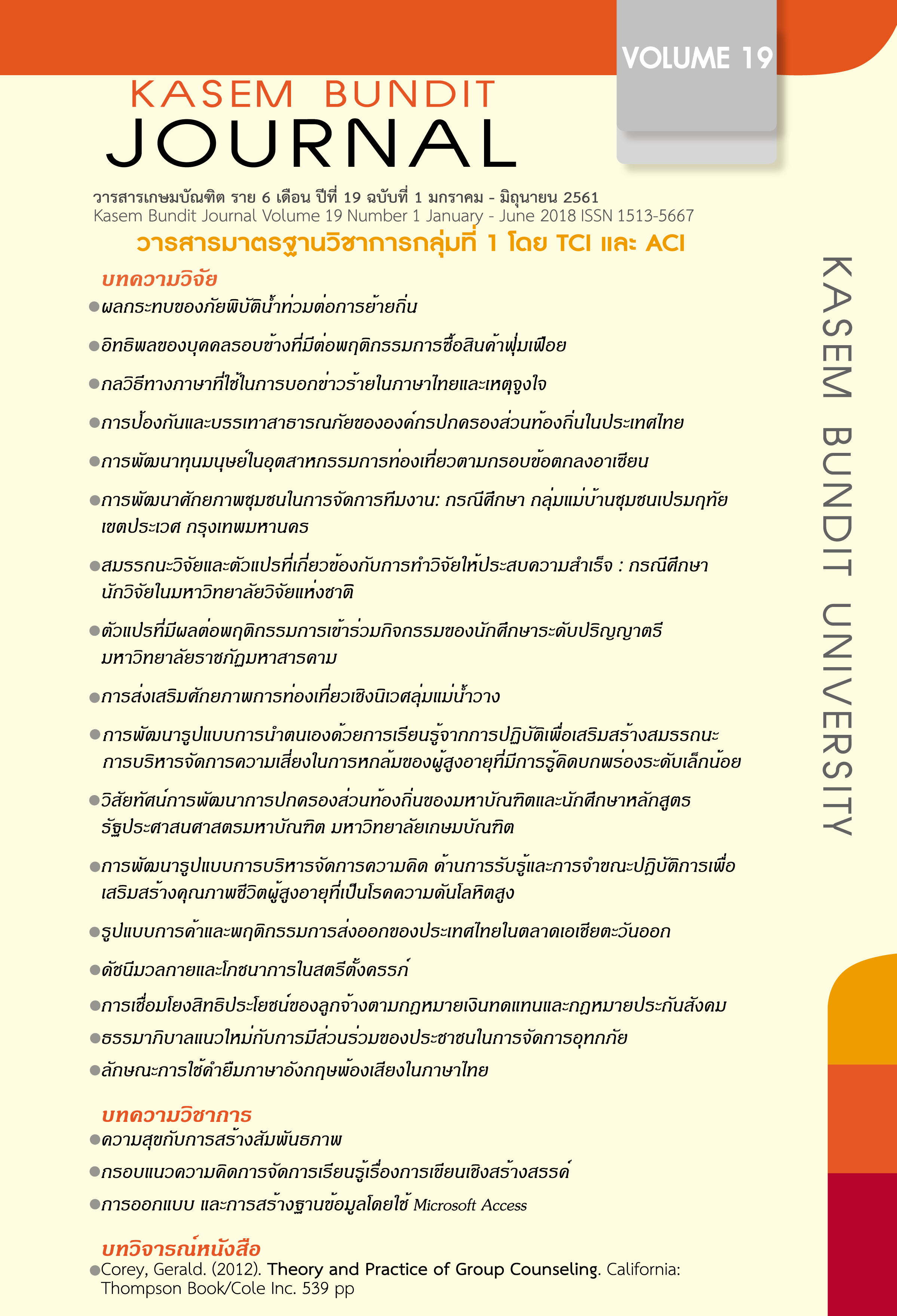New Public Governance and Citizen Participation in Flood Management
Keywords:
New Public Governance, citizen participation, flood managementAbstract
Citizen participation is one of the significant aspects of new public governance. The promotion of citizen participation plays the vital role to the effectiveness of flood mitigation in most countries around the globe. The research objectives comprise the in-depth analysis and synthesis of concepts and theories of citizen participation and the presentation of procedural details which can be applied by the Bangkok Metropolitan Area officers in flood management. The research results disclose that best practices in initiating citizen participation consist of the definition of the purposes of citizen participation, the multi-level of control, the definition of stakeholders and the public, the analysis of stakeholders, the intensiveness of participation, the methods of participation, the expectation management and the feedback..
References
Arnstein, Sherry R. 1969. “A Ladder of Citizen Participation”, JAIP. Vol. 35, No. 4 July, 216-224.
Berner, Maureen M., Amos, Justin M. and Morse, Ricardo S. (2011). “What Constitutes Effective Citizen Particiaption in Local Government? Views from City Stakeholders,” PAQ. Spring: 128-163.
Bingham, Lisa Blomgren, Tina Nabatchi, and Rosemary O’Leary. (2005). “The New Governance: Practices and Processes for Stakeholder and Citizen Participation in the Work of Government,” Public Administration Review. Sep/Oct; 65,(5).
Bradford, R.A. et al. (2012). “Risk Perception – Issues on Flood Management in Europe,” Natural Hazards and Earth System Sciences. 2299-2309.
Burke, E.M. (1979). A Participatory Approach to Urban Planning. New York: Human Science Press.
Day, D. (1997). “Citizen Participation in the Planning Process: An Essentially Contested Concept?” Journal of Planning Literature. 11(3), 421-434.
Fagence, M. (1977). Citizen Participation in Planning. Oxford: Pergamon.
Fainstein, S.S. & N.I. Fainstain. (1985). “Citizen Participation in Local Government”. In D.R. Judd.ed. Public Policy Across States and Communities. Greenwich, CT: JAI Press.
Firus et al. (2011). The Participation of the Public and Stakeholders in Flood Risk Management. EUIPA 2010 Twinning Project.
Frederickson, H. George. (1991). “Toward a Theory of the Public for Public Administration”. Administration and Society. 22(4): 395-417.
----------. (1999). “The Repositioning of American Public Administration”. PS: Political Science and Politics. 32(4): 701-11.
Irvin, Renee and Stansbury, John. (2004). “Citizen Participation in Decision Making: Is It Worth the Effort?” Public Administration Review.
Kettl, Donald F. (2002). The Transformation of Governance: Public Administration for Twenty-First Century America. Baltimore: Johns Hopkins University Press.
King, Cheryl Simrell, Feltey, Kathryn M. and Susel, Bridget O’Neil. (1998). “The Question of Participation: Toward Authentic Public Participation in Public Administration,” Public Administration Review. Vol. 58, No. 4. July-August: 317-326.
Rowe, Gene and Frewer, Lynn J. (2004). “Evaluating Public Participation Exercises: A Research Agenda,” Science, Technology & Human Values. 29(4): 512-556.
Salamon, Lester, ed. (2002). The Tools of Government: A Guide to the New Governance. New York: Oxford University Press.
Smith, Steven Rathgeb and Ingram, Helen. (2002). “Policy Tools and Democracy.” in The Tools of Government: A Guide to the New Governance, edited by Lester Salamon. New York: Oxford University Press. 56-84.
Stivers, Camilla. (1991). “Some Tensions in the Notion of “The Public as Citizen,”: Rejoinder to Frederickson,” Administration and Society. 22(4): 418-23.
Webler, Thomas and Tuler, Seth. (2000). “Fairness and Competence in Citizen Participation: Theoretical Reflections from a Case Study,” Administration and Society. November.
Wondolleck, J. and S. Yaffee. (2000). Making Collaboration Work: Lessons from Innovation in Natural Resource Management. Washington, DC: Island Press.
Downloads
Published
How to Cite
Issue
Section
License
ทัศนคติ ความคิดเห็นใด ๆ ที่ปรากฏในวารสารเกษมบัณฑิตฉบับนี้เป็นของผู้เขียน โดยเฉพาะ มหาวิทยาลัยเกษมบัณฑิตและบรรณาธิการ ไม่จำเป็นต้องมีความเห็นพ้องด้วย







